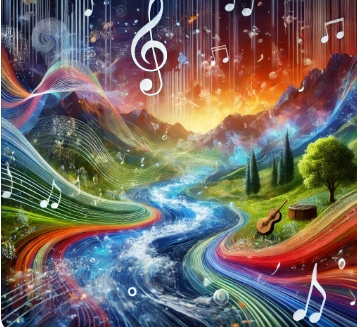Travel is often described as a feast for the eyes, but some destinations captivate visitors in another profound way—through sound. These soundscapes, whether natural or urban, have a transformative power that stays with you long after you leave. From the haunting echoes of Antelope Canyon to the melodic rhythms of Kyoto’s bamboo forests, soundscapes shape how we experience the world. They remind us to listen, tune in, and appreciate the rich auditory tapestries that surround us in these remarkable locations.
Antelope Canyon: Nature’s Echo Chamber
 Nestled in Arizona, Antelope Canyon is a sandstone slot canyon famous for its stunning visuals and equally mesmerizing acoustics. The narrow passageways amplify sound, creating echoes that seem to dance between the canyon walls. A study conducted in 2024 by the National Park Service found that Antelope Canyon’s acoustic properties enhance the experience of its natural formations, allowing visitors to connect with the environment in a unique way. Guided tours often include flute performances, where the sound reverberates through the canyon, blending seamlessly with the gentle whisper of wind. This creates an immersive sensory experience unlike any other. Source
Nestled in Arizona, Antelope Canyon is a sandstone slot canyon famous for its stunning visuals and equally mesmerizing acoustics. The narrow passageways amplify sound, creating echoes that seem to dance between the canyon walls. A study conducted in 2024 by the National Park Service found that Antelope Canyon’s acoustic properties enhance the experience of its natural formations, allowing visitors to connect with the environment in a unique way. Guided tours often include flute performances, where the sound reverberates through the canyon, blending seamlessly with the gentle whisper of wind. This creates an immersive sensory experience unlike any other. Source
The Bamboo Forest of Kyoto
 Kyoto’s Arashiyama Bamboo Grove is a destination where sound plays a central role in its magic. The forest’s towering bamboo stalks sway with the wind, producing a melodic rustling sound. In 2024, UNESCO designated the grove as a World Heritage Soundscape, recognizing its ability to create a sense of peace through sound. Visitors often describe the experience as meditative, with the rustling leaves blending harmoniously with the distant chirping of birds. Kyoto’s tourism board has embraced this auditory appeal, encouraging travelers to visit during quieter hours for the most serene experience. Source
Kyoto’s Arashiyama Bamboo Grove is a destination where sound plays a central role in its magic. The forest’s towering bamboo stalks sway with the wind, producing a melodic rustling sound. In 2024, UNESCO designated the grove as a World Heritage Soundscape, recognizing its ability to create a sense of peace through sound. Visitors often describe the experience as meditative, with the rustling leaves blending harmoniously with the distant chirping of birds. Kyoto’s tourism board has embraced this auditory appeal, encouraging travelers to visit during quieter hours for the most serene experience. Source
Echo Point at Grandfather Mountain
 Located in North Carolina, Echo Point at Grandfather Mountain offers a natural acoustic phenomenon where sounds bounce off the surrounding cliffs. Shouts or musical notes from one side are returned in perfect clarity from the opposite side, creating a dramatic echo effect. According to a 2024 report by the North Carolina Department of Natural and Cultural Resources, this site attracts thousands of visitors annually who come specifically to experience the echo. For adventurous travelers, hiking trails around the mountain offer the chance to explore other sound-rich environments, including cascading waterfalls and whispering pine forests. Source
Located in North Carolina, Echo Point at Grandfather Mountain offers a natural acoustic phenomenon where sounds bounce off the surrounding cliffs. Shouts or musical notes from one side are returned in perfect clarity from the opposite side, creating a dramatic echo effect. According to a 2024 report by the North Carolina Department of Natural and Cultural Resources, this site attracts thousands of visitors annually who come specifically to experience the echo. For adventurous travelers, hiking trails around the mountain offer the chance to explore other sound-rich environments, including cascading waterfalls and whispering pine forests. Source
The Singing Dunes of Kazakhstan
In Kazakhstan’s Altyn-Emel National Park, the Singing Dunes create an otherworldly soundscape. When wind sweeps across the sand, it produces a low, rumbling sound reminiscent of a deep hum or organ music. Scientists studying the dunes in 2024 identified the phenomenon as a result of sand grains vibrating against one another under specific conditions. Local legends say the dunes are singing spirits, adding a layer of cultural mystique to the experience. For visitors, climbing the dunes and triggering the sound themselves is an unforgettable highlight. Source
The Whispering Walls of the Taj Mahal
While the Taj Mahal is renowned for its architectural beauty, its acoustic design is equally impressive. Engineers of the 17th century created a structure that amplifies even the softest sounds. A 2024 study published by the Archaeological Survey of India revealed that the Taj Mahal’s central dome reflects sound waves in such a way that a single clap can be heard multiple times. Guides often demonstrate this effect, showcasing how the structure was designed to enhance prayers and chants. The Taj Mahal’s soundscape remains an essential part of its spiritual and cultural significance. Source
Shibuya Crossing: The Sound of Chaos
In contrast to nature’s serenity, Shibuya Crossing in Tokyo offers a soundscape that celebrates urban chaos. Known as one of the busiest pedestrian crossings in the world, Shibuya is a symphony of human activity. From the rhythmic shuffle of footsteps to the overlapping chatter and electronic jingles of advertisements, the area pulsates with energy. In 2024, Tokyo’s tourism board reported that Shibuya attracts over 2.4 million visitors annually, many of whom come to witness this vibrant auditory and visual spectacle. The crossing is a reminder that soundscapes can be thrilling even in the midst of city noise. Source
The Soundscapes of Reykjavik’s Harpa Concert Hall
Reykjavik’s Harpa Concert Hall is a modern architectural wonder designed with acoustics in mind. The building’s glass façade, inspired by Iceland’s volcanic landscape, enhances the sound quality within its concert halls. Harpa has become a global destination for music lovers, hosting performances that range from classical to experimental. A 2024 study by the Icelandic Music Center highlighted Harpa’s innovative design, which optimizes sound distribution for both performers and audiences. Visitors can take guided tours to learn about the science behind its world-class acoustics. Source
Why Soundscapes Matter in Travel
Traveling through soundscapes offers a unique way to connect with the world. Unlike sights or smells, sounds often evoke deeper emotional responses and memories. Whether you’re listening to the haunting echoes of Antelope Canyon or the bustling chaos of Shibuya, these soundscapes create a sense of place that’s hard to replicate. They remind us to slow down, listen, and appreciate the layers of life that exist beyond what we see. For travelers seeking meaningful experiences, soundscapes provide a window into the soul of a destination.








